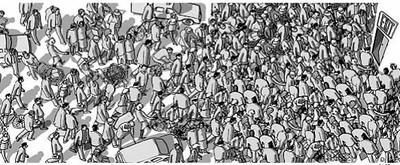Disney, in Its Latest Translation
Seeks to Balance Appeal
To Aficionados and Novices
By GEOFFREY A. FOWLER
Staff Reporter of THE WALL STREET JOURNAL
September 16, 2005
HONG KONG -- Americans Eric and Barbara Roque flew more than 11,000 kilometers last weekend to visit a place they already know intimately. "Oh, it looks just like ours," said 44-year-old Mr. Roque when the green metal gates opened to the public Monday at the world's newest Walt Disney Co. amusement park here.
The couple, whose matching wedding rings feature Mickey Mouse ears, own year-round passes to the original Disneyland in Anaheim, California, just 20 minutes from their home. "Like some people go to bars to hang out, Disney is our hangout," said Mrs. Roque, a 49-year-old who works at retailer Home Depot Inc.
Meanwhile, Hong Kong teen Lee Chen skipped school Monday to make his first visit to a Disneyland with his brother Naphen, who is 17. They live just two subway stops from the new park. Lee, 14, has been on a roller coaster but for Naphen it would be a new adventure. Naphen already owns one piece of Disney merchandise: English-language learning tapes featuring Scrooge McDuck's nephews, whose names he remembers only in Chinese.
Their different experiences sum up the central challenge of Hong Kong Disneyland, Disney's first attempt to cater to consumers in the developing world through theme parks. On the one hand, it must meet expectations of Disney devotees who are loyal to Walt Disney's 50-year-old creations and can tell the difference between chipmunk characters Chip and Dale. (Chip has a dot in his nose, explains Mr. Roque.) On the other, the park must educate millions of Chinese who know little of Alice in Wonderland -- much less how to work the spinning wheel on the Mad Hatter Tea Cups ride.
A tour of the park on opening day with the Roques and the Chen brothers revealed some signs of how Disney aims to strike that balance. Entering the park, the Roques immediately started to spot similarities -- as well as subtle differences. "Look at City Hall! It looks lower," said Mr. Roque, surveying Main Street U.S.A. Like most of the other parks, Main Street features a collection of 19th-century buildings topped with the occasional American flag.
With about a third of the park's guests expected to be Cantonese-speaking Hong Kong residents, another third mostly Mandarin-speaking mainland Chinese, and the rest expected to come mostly from around the region, speaking English could be a plus in the park. The Jungle River Cruise, a live-guided boat ride through African and Asian terrain, is offered in three languages. But as each language gets its own line, English-language riders Monday had less of a wait.
Onboard the cruise, the Roques delighted in the differences in Hong Kong, where the boat sails down a considerably larger river than in other parks, and encourages riders to wave and cheer at guests at the vine-covered Tarzan Treehouse.
The Chen brothers weren't quite so enthusiastic. The plastic and metal offerings in Adventureland are no match for the nearby wilds of Southeast Asia, a short plane ride from Hong Kong and filled with real jungle ruins, bamboo bridges and wildlife.
Continuing around the park from Adventureland to Fantasyland, the group hit the most classic Disney attraction of all: the Mad Hatter Tea Cups, which spins riders around inside oversize cups. Naphen wasn't familiar with the ride, and initially didn't want to wait in the 10-minute line. But once the brothers were on, and started spinning their own cups, they were hooked.
This time of year, when Hong Kong hits 32-degree Celsius humid days, wised-up residents are used to hanging out in air-conditioned malls. There's little of that kind of escape at Hong Kong Disneyland. "I don't think I dripped quite as much in Florida," said Mr. Roque, mopping his head.
Next up: the space-themed Tomorrowland, to ride the iconic indoor Space Mountain roller coaster. Hong Kong's version of the three-minute ride, based on the recently updated Space Mountain in Anaheim, has speakers built into the seats, enhancing the special effects that simulate whizzing through space. And as in Anaheim, Mrs. Roque knew to strike a pose when the camera flashed at the end of the ride. While the Roques bought prints of their photos from Disney, most riders simply snapped a picture of the photos displayed on a screen with their own cellphone cameras. The Chen brothers took their own photos.
Even though the Hong Kong version of the ride doesn't flip upside down, as does the one at Paris Disneyland, Naphen and Lee were sold. "I would come back to ride Space Mountain with my friends," said Naphen. His brother finally broke into a grin.
Space Mountain is the only high-speed attraction at Hong Kong Disneyland. "This is probably the most tame of the Disney parks in terms of rides," said Mrs. Roque. According to Disney, the company's research showed that Chinese tourists are less interested in fast rides than in taking photographs, shopping, and watching fireworks. As a result, there's no Haunted Mansion, Pirates of the Caribbean, or Matterhorn -- three popular attractions at other parks.
(The park does, though, have subtle Chinese influences -- a feng shui expert was brought in to help shape the design of the site's water and walkways to bring good fortune.)
So, instead of cramming the park with roller coasters, Disney pushes gentle character education. Many new attractions teach the audience the stories behind Disney movies or let visitors take their photographs with cartoon characters.
Sometimes, though, the characters get lost in translation. Marie the Cat, a minor Disney character from Disney's 1970 cartoon "The Aristocats" -- unrecognizable to many Western tourists -- turns up in shows and in person around the park to greet Chinese guests, well-known for their adoration of another cat not owned by Disney: Sanrio's Hello Kitty.
At the end of the day, the Chens left smiling but weren't in a hurry to return. "I'd come again with my friends. But next time I come, I would just do two rides: Space Mountain and Buzz Lightyear," said Naphen. His brother wasn't as upbeat. "It is quite expensive," said Lee. "For ($45, or €37) you could buy...a T-shirt and eat a nice meal."





